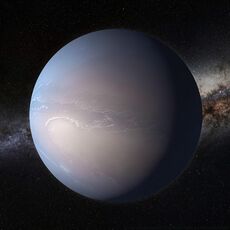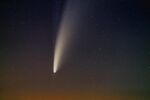Astronomy:Gliese 414 Ac
 Artistical representation of a super-Neptune exoplanet. | |
| Discovery[1][2] | |
|---|---|
| Discovered by | Dedrick et al. |
| Discovery date | 2020 |
| Radial velocity | |
| Designations | |
| HD 97101 Ac, HIP 54646 c[3] | |
| Orbital characteristics | |
| 1.43±0.06 astronomical unit|AU[2] | |
| Eccentricity | 0.093+0.1 −0.064[2] |
| Orbital period | 748.3+1.3 −1.2 d[2] |
| 74°+74° −200°[2] | |
| Star | GJ 414 A |
| Physical characteristics | |
| Mean radius | 8.78+4.03 −2.66 R⊕ (0.783+0.359 −0.237 RJ)[2] |
| Mass | 56.27+10.43 −9.91 M⊕ (0.177+0.03 −0.031 Jupiter mass)[2] |
| Physics | 123.3±13.2 K (−149.7 °C (−237.5 °F))[2][lower-alpha 1] |
Gliese 414 Ac, or GJ 414 Ac, is an exoplanet orbiting Gliese 414 A, a K-type main-sequence star located 39 light-years from Earth, in the constellation Ursa Major.[4][note 1] It is classified as a super-Neptune exoplanet, being at least 56 times more massive than the Earth and about 9 times larger.[2] Gliese 414 Ac orbits its parent star at a distance of 1.43 astronomical units and completes one revolution around it every 2 years and 18 days.[2] It is one of the two planets orbiting Gliese 414 A, the another is Gliese 414 Ab, a sub-Neptune.[3]
Characteristics
Gliese 414 Ac is classified as a super-Neptune (or sub-Saturn),[2][3] a type of exoplanets that are more massive than Neptune, but less massive than Saturn, having masses between 20 and 80 M⊕.[5] The planet has a minimum mass of 56 M⊕ and a radius of 8.78 R⊕,[2] both values between Neptune and Saturn.[lower-alpha 2]
It completes one orbit around its star approximately every two years, and is located at a distance of 1.43 astronomical units (214,000,000 km) from it, too far to be located in the habitable zone of its star, which extends up to 0.7 AU.[2] Due to the great separation from its star, the planet is frigid, having an equilibrium temperature of around -150 °C,[2] comparable to Saturn, which has a temperature of -140 °C.[7] Gliese 414 Ac is as a potential candidate for future direct imaging missions.[2][3][8]
Discovery
Gliese 414 Ac was discovered in 2020 by analyzing radial velocity data from Keck's HIRES instrument and the Automated Planet Finder at Lick Observatory, as well as photometric data from KELT.[3]
Host star
Gliese 414 Ac orbits Gliese 414 A, an orange dwarf (spectral type K7V[9]) that is smaller and cooler than the Sun. The star has a radius of 0.679 R☉, a mass of 0.65 M☉ and a temperature of 4,120 K (3,850 °C).[2] It is a binary star, having an orbital companion called Gliese 414 B, a red dwarf star that is at a projected distance of 408 astronomical units from it.[3][8]
The stellar system is located about 39 light-years from the Earth, in the constellation Ursa Major.[10][note 1] Both stars are too faint and can't be seen with the naked eye.[10]
There is another planet orbiting Gliese 414 A. Named Gliese 414 Ab, it is a sub-Neptune that is located 0.24 astronomical unit|AU (36,000,000 km) from it (6 times closer than Gliese 414 Ac).[2] The planet has an eccentric orbit and its distance from its star varies between 0.13 and 0.34 AU, which means that it is occasionally located in the optimistic habitable zone.[2] The planet has a radius of 2.95 R⊕ and a minimum mass of 7.6 M⊕.[2]
See also
- List of coolest exoplanets
- Super-Neptune
- Ursa Major
- Gliese 414
- List of star systems within 35-40 light years
Notes and references
- ↑ Martin, Pierre-Yves (2020). "Planet GJ 414 A b" (in en). Extrasolar Planets Encyclopaedia. https://exoplanet.eu/catalog/gj_414_a_b--7489/.
- ↑ Jump up to: 2.00 2.01 2.02 2.03 2.04 2.05 2.06 2.07 2.08 2.09 2.10 2.11 2.12 2.13 2.14 2.15 2.16 2.17 2.18 Dedrick, Cayla M.; Fulton, Benjamin J.; Knutson, Heather A.; Howard, Andrew W.; Beatty, Thomas G.; Cargile, Phillip A.; Gaudi, B. Scott; Hirsch, Lea A. et al. (2021-02-01). "Two Planets Straddling the Habitable Zone of The Nearby K Dwarf Gl 414A". The Astronomical Journal 161 (2): 86. doi:10.3847/1538-3881/abd0ef. ISSN 0004-6256. Bibcode: 2021AJ....161...86D.
- ↑ Jump up to: 3.0 3.1 3.2 3.3 3.4 3.5 "Open Exoplanet Catalogue - Gliese 414 Ab". https://www.openexoplanetcatalogue.com/planet/GJ%20414%20A%20b/.
- ↑ "Gliese 414 | NASA Exoplanet Archive". https://exoplanetarchive.ipac.caltech.edu/overview/GJ%20414.
- ↑ Staff, Space.com (2009-03-14). "Super-Neptune Planet Found" (in en). https://www.space.com/6338-super-neptune-planet.html.
- ↑ "Planetary Physical Parameters". https://ssd.jpl.nasa.gov/planets/phys_par.html.
- ↑ "Solar System Temperatures - NASA Science" (in en). https://science.nasa.gov/resource/solar-system-temperatures/.
- ↑ Jump up to: 8.0 8.1 Anderson, Natali (2020-09-21). "Astronomers Find Two Massive Exoplanets in Nearby Binary System | Astronomy | Sci-News.com" (in en-US). https://www.sci.news/astronomy/two-massive-exoplanets-nearby-binary-system-08870.html.
- ↑ Jump up to: 9.0 9.1 "HD 97101". https://simbad.cds.unistra.fr/mobile/object.html?object_name=HD%2097101.
- ↑ Jump up to: 10.0 10.1 "Gliese 414". https://www.stellarcatalog.com/stars/gliese-414-a.
- ↑ Assuming a bond albedo of 0.343, the same as Saturn.
- ↑ Neptune has a mass of 17.15 M⊕ and a radius of 3.88 R⊕, while Saturn has a mass of 95.2 M⊕ and a radius of 9.45 R⊕.[6]
- ↑ Jump up to: 1.0 1.1 Obtained with a right ascension of 11h 11m 5.17s and a declination of +30° 26′ 45.7″[9] on this website.
 |




